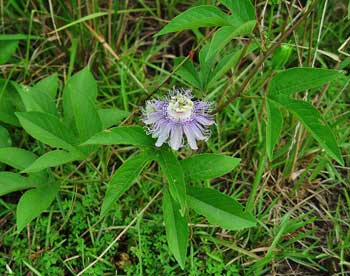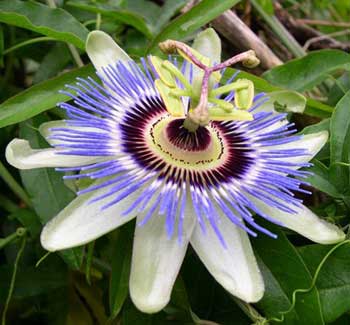Contents:
Common Names | Parts Usually Used | Plant(s) & Culture | Where Found | Medicinal Properties | Biochemical Information
Legends, Myths and Stories | Uses | Formulas or Dosages | How Sold | Warning | Bibliography
Scientific Names

- Passiflora incarnata L.
- Passifloraceae
- Passion-flower family
Common Names
- Maypops
- Maypop herb
- Passion vine
- Purple passion flower
Parts Usually Used
Plant, flower, leaves
Back to Top

Description of Plant(s) and Culture
Passion flower is a woody, hairy, climbing vine; the stems, from 10-30 feet long, climb by means of axillary tendrils. The alternate, serrate leaves are palmately 3 to 5 lobed. Solitary, axillary, white flowers with purple, blue, or pink calyx crown bloom from May to July. The fruit is an edible, many-seeded berry (maypop) almost as large as a chicken egg.
Back to Top
Where Found
Grows wild in the southern United States, from Virginia and Florida westward to Missouri and Texas. Also cultivated in cooler climates; grows best in partial shade in rich, moist, well-drained soil. Native of Southern United States and the West Indies.
Back to Top
Medicinal Properties
Anodyne, antispasmodic, diaphoretic, hypnotic, nervine, sedative
Back to Top
Biochemical Information
Alkaloids including passiflorine, harmine, and harmol, and flavonic derivatives
Back to Top
Legends, Myths and Stories
There are more than 400 different species growing in North America and Mexico. Many of them have fruits with juicy pulp, which are eaten as fruit and yield a delicious juice that is called passion juice.
The priests who accompanied the conquistadors to the New World in the 16th century considered the discovery of this beautiful flowering vine in South America to be a propitious, God-given sign that Christianity would be well received in the new land. Passion flower got the name from supposed resemblance of parts of the flowers to Jesus’ wounds, crown of thorns, etc.
They gave the plant its name, by a Jesuit priest, Padre Ferrari, because the various parts of the flower appeared to them to be symbolic of Christ’s passion: the 10 petals represent the faithful apostles, excluding the traitor Judas and also Peter for his denial; the corolla symbolizes the crown of thorns; the 5 stamens stand for the 5 wounds; the ovary suggests the hammer with which Christ was nailed to the cross; and the styles with their rounded heads provide the nails. Because the natives relished the yellow fruit of the plant, the priests were encouraged in their mission, interpreting the eating of the fruit as symbolic of the Indians’ hunger for Christianity.
Padre Ferrari served as a missionary to Mexico.
The vines of the passion flower often climb to the highest treetops and sends out an abundance of radiant white and purple flowers.
Back to Top
Uses
Passionflower is one of nature’s best tranquilizers, recommended for times of extreme emotional upset.
Most commonly used for nervous conditions such as insomnia, restlessness, hysteria, mild depression, Parkinson’s disease, seizures, epilepsy, neuralgia, shingles, slightly reduces blood pressure, increases respiratory rate, good for muscle cramps, decreases motor activity, and nervous headache. Normally it is used as part of a prolonged treatment and in the form of professionally prepared medications. The fruit is rich in flavonoids and is diuretic and a nutritive tonic; fruits are edible and delicious.
Native Americans poulticed the root for boils, cuts, earaches, and inflammation.
Back to Top
Formulas or Dosages
Use professionally prepared medications.
Tincture: take 15 to 60 drops in water, as needed. For restlessness in children, give 3 to 10 drops in water every 30 minutes until results are obtained.
For insomnia: Tincture of Skullcap, 1 oz. and Tincture of Passion flower, 1 oz. Dose: 20-60 drops in water as required.
Back to Top
How Sold
Tincture or capsules
Back to Top
Warning
Potentially harmful in large amounts.
Do not take during pregnancy.
May cause drowsiness in some people, care should be taken in driving or operating machinery.
Back to Top
Bibliography
![]() The Complete Medicinal Herbal
The Complete Medicinal Herbal, by Penelope Ody, Dorling Kindersley, Inc, 232 Madison Avenue, New York, NY 10016, First American Edition, copyright 1993
![]() Eastern/Central Medicinal Plants
Eastern/Central Medicinal Plants, by Steven Foster and James A. Duke., Houghton Mifflin Company, 215 Park Avenue South, New York, NY 10000
 The Healing Plants
The Healing Plants, by Mannfried Pahlow, Barron’s Educational Series, Inc. 250 Wireless Blvd., Hauppauge, NY 11788, 1992
![]() The Herb Book
The Herb Book, by John Lust, Bantam Books, 666 Fifth Avenue, New York, NY. copyright 1974.
 Earl Mindell’s Herb Bible
Earl Mindell’s Herb Bible, by Earl Mindell, R.Ph., Ph.D., Simon & Schuster/Fireside, Rockefeller Center 1230 Avenue of the Americas, New York, New York 10020
Herbal Gardening, compiled by The Robison York State Herb Garden, Cornell Plantations, Matthaei Botanical Gardens of the University of Michigan, University of California Botanical Garden, Berkeley., Pantheon Books, Knopf Publishing Group, New York, 1994, first edition
![]() Indian Herbalogy of North America
Indian Herbalogy of North America, by Alma R. Hutchens, Shambala Publications, Inc., Horticultural Hall, 300 Massachusetts Avenue, Boston, Massachusetts 02115, 1973
 The Magic of Herbs in Daily Living
The Magic of Herbs in Daily Living, by Richard Lucas, Parker Publishing Co. (1988).
![]() The Nature Doctor: A Manual of Traditional and Complementary Medicine
The Nature Doctor: A Manual of Traditional and Complementary Medicine, by Dr. H.C.A. Vogel; Keats Publishing, Inc., 27 Pine Street (Box 876) New Canaan, CT. 06840-0876. Copyright Verlag A. Vogel, Teufen (AR) Switzerland 1952, 1991
![]() Planetary Herbology
Planetary Herbology, by Michael Tierra, C.A., N.D., O.M.D., Lotus Press, PO Box 325, Twin Lakes. WI 53181., Copyright 1988, published 1992
![]() The Yoga of Herbs: An Ayurvedic Guide to Herbal Medicine
The Yoga of Herbs: An Ayurvedic Guide to Herbal Medicine, by Dr. David Frawley & Dr. Vasant Lad, Lotus Press, Twin Lakes, Wisconsin, Second edition, 1988.
![]() Webster’s New World Dictionary
Webster’s New World Dictionary, Third College Edition, Victoria Neufeldt, Editor in Chief, New World Dictionaries: A Division of Simon & Schuster, Inc., 15 Columbus Circle, New York, NY 10023
 The Rodale Herb Book: How to Use, Grow, and Buy Nature’s Miracle Plants (An Organic gardening and farming book)
The Rodale Herb Book: How to Use, Grow, and Buy Nature’s Miracle Plants (An Organic gardening and farming book), edited by William H. Hylton, Rodale Press, Inc. Emmaus, PA, 18049., 1974
